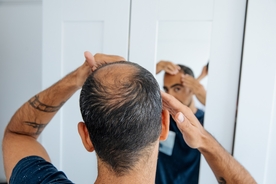Hair loss is an inevitable reality for the majority of men - and others too.
While a sign of virility in men, having a head like a well-polished egg has been deemed less attractive by many, with just 19% of women between the ages of 18 to 24 finding the trait attractive. The stats aren't much better for older women either, with just 44% of those between 35 and 44 attesting to liking badness, Prim & Prep reports.
However, if your hairline is slowly but surely receding, fear not. A solution for this age-old problem that's not a hair transplant could be a reality in the not too distant future.

This is all thanks to the work of scientists from the Sanford Burnham Prebys Medical Discovery. In short, they've found a way of using human pluripotent stem cells to grow new hair follicles through the skin.
Admittedly, they've only managed to pull this feat off on mice so far, but if trials in humans are successful, it could be a gamechanger. Never again will young men fear looking like Voldemort later in life!

This excellent news was delivered to the world at the International Society for Stem Cell Research (ISSCR) annual conference in Los Angeles, California.
Dr. Alexey Terskikh, a professor involved in the trial, said: "Our new protocol described today overcomes key technological challenges that kept our discovery from real-world use.
"Now we have a robust, highly controlled method for generating natural-looking hair that grows through the skin using an unlimited source of human iPSC-derived dermal papilla cells. This is a critical breakthrough in the development of cell-based hair-loss therapies and the regenerative medicine field."

This new technique is so effective that, if successful, will enable scientists to control the amount of hair grown and in which direction.
Dr. Richard Chaffoo, a medical adviser to Stemson Technologies, said: "Hair loss profoundly affects many people's lives. A significant part of my practice involves both men and women who are seeking solutions to their hair loss.
"I am eager to advance this groundbreaking technology, which could improve the lives of millions of people who struggle with hair loss."


